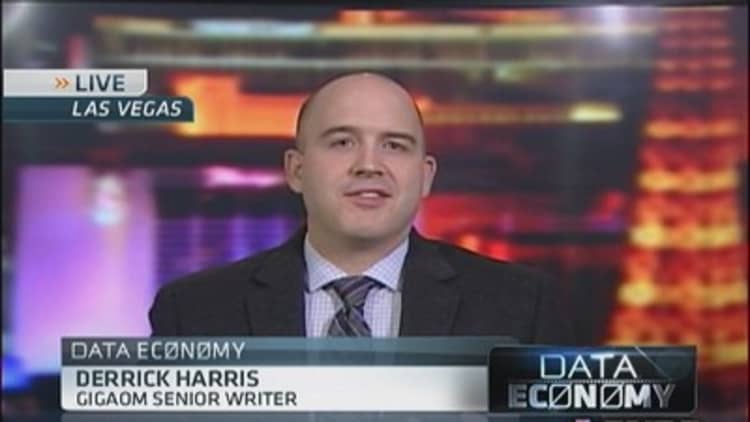Monsanto's new crop science
It's too late to stop the rise of genetically modified crops such as the Roundup Ready ones made famous by agricultural giant Monsanto. GMO crops have proliferated so extensively across the grain belt there is probably no going back for most of the eating public. So maybe at least science can balance Frankenfood with some Google-esque algorithms that allow us to farm—whatever worm genes we are farming—better.
Monsanto announced this past week the $930 million acquisition of Climate Corp., a pioneer among a new breed of data analytics firms focused on agricultural issues like crop insurance and agricultural risk management, which was founded by two former Google engineers.
"The Climate Corporation is focused on unlocking new value for the farm through data science," Monsanto chief Hugh Grant said in a statement. "Everyone benefits when farmers are able to produce more with fewer resources."
(Read more: Holiday hiring goes high tech)
So just how much money is all that Twitter data worth?
The social media company finally filed its complete S-1 for its upcoming IPO this past week, and it reveals that Twitter has more than 215 million monthly active users, 100 million of whom are daily active users. It has seen rapid growth—though maybe not quite as much as some social media peers; estimates for its ad revenue per user are below those of other social media leaders, including Facebook. Last year, Twitter revenue rose 198 percent, to about $317 million, while its net loss declined 38 percent, to about $79 million, the filing said.
Mobile is the primary driver of its business, and 75 percent of monthly active users access Twitter from a mobile device, according to the filing. Those monthly active mobile users account for over 65 percent of Twitter's advertising revenue from mobile. Twitter said it expects its mobile revenue to continue to grow in the near term.

Big data is the new A-bomb
Not since Robert Oppenheimer faced down his demons after spearheading the Manhattan Project have scientists been faced with as big an ethical dilemma as big data represents, says Albert-László Barabási,a physicist and network scientist at Northeastern University and Harvard Medical School, in a Politico op-ed this past week.
"This summer, while visiting my hometown in Transylvania, I had the opportunity to talk with a neighbor who spent years as a political prisoner. Once freed ... he received transcripts of his own communications after the fall of communism. They spanned seven volumes. It was toxic and dehumanizing. ... So why are we beginning to spread communism 2.0 around the world, a quarter-century after the Iron Curtain's collapse? This is effectively what NSA surveillance has become. If we scientists stay silent, we all risk becoming digitally enslaved," Barabási wrote.
(Read more: The Moneyball misplay: Sports big error?)
Does big data lead to better decisions? In India, the answer is yes
Ninety-one percent of Indian businesses that responded to a survey conducted by software giant EMC said that big data will lead to better decision-making, according to the Times of India.
EMC found that 68 percent of businesses think big data will be a key factor in determining winners and losers and 35 percent said it has already given them a competitive edge. Sixty-eight percent of respondents said business success will become near-impossible without the use of big data tools.
Who uses big data the most (excluding the NSA)
Indian firms are into big data, but Asia actually lags the rest of the business world in adoption of data analysis. A recent Gartner report showed that Asia-Pacific is well behind the 37 percent big data adoption rate of U.S. businesses. Overall, 64 percent of businesses globally have already invested in big data or plan to do so by June 2015, an increase of 6 percentage points on the 2012 Gartner survey. The 38 percent of U.S. businesses using big data leads Europe, the Middle East and Africa, at 26.8 percent; Asia, at 25.6 percent; and Latin America, at 17.8 percent. Media and communications and financial companies have been among the leaders in early adoption, while government and utilities lag, Gartner said.
And once all that data is available, one of the big question becomes: What happens when big data tells you something you don't like?
(Read more: 10 surprising ways companies are using your data)
How big data will conquer malaria
Most data geeks by now know the tale of Google using keyword search activity to catch the next flu outbreak—just look for an increased search cluster around the words "runny nose" and "cough" and "chills." And there are cutting edge viral researchers arming medical outposts in the furthest reaches of the Third World with cellphone text codes to get out the word as fast as possible about potential human pandemics. IBM is big in this game, too, and has taken on one of the world's most persistent diseases: malaria. The latest version of IBM's STEM software for disease data analytics is due out in the middle of October.
Why wearable devices may not catch on as quick as you think
Tech giants are betting big on wearables as the next big wave in consumer tech, but the wearable market may be harder to conquer than the companies expect. Unlike the mobile device market—where several smartphones and tablets reign supreme—consumers will demand more choice when it comes to wearables, according to Hosain Rahman, founder and CEO of Jawbone, speaking at this past week's Fast Company Innovation by Design conference.
—By Eric Rosenbaum, CNBC.com.
-- Correction: An earlier version of this story misstated the price Monsanto paid for Climate Corp.






